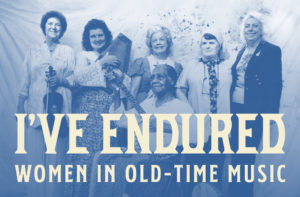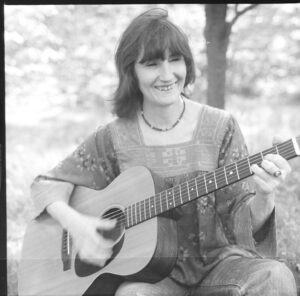
Voice Magazine for Women, a free, monthly publication distributed regionally in Northeast Tennessee and Southwest Virginia to 650 locations, partners with the Birthplace of Country Music an affiliate of the Smithsonian Institution, to take you inside the special exhibit I’ve Endured: Women Old-Time Music, on display at the museum through December 31, 2023. Each month through the duration of the exhibit, Voice features impactful stories of the hidden heroines, activists, and commercial success stories of the women who laid the foundation for country music. Inspiring, insightful, and Dolly-approved, you may just find a piece of yourselves, or a loved one, in the stories of some of these hidden figures in American music.
With their permission, we have duplicated our “I’ve Endured: Woman in Old-Time Music” special feature article for this month – we hope you enjoy it! To read this month’s issue in its entirety, click here.
The Stories of I’ve Endured: Women in Old-Time Music
Hazel Dickens and Alice Gerrard
By Guest Contributor Charlene Tipton Baker

“When I was 13 years old I heard a Hazel Dickens song and it changed my life. I would not be doing what I do without her, Elizabeth Cotten, Ola Belle Reed, Alice Gerrard, and so many other incredible women featured in this exhibit.” ~ Molly Tuttle
Hazel Dickens and Alice Gerrard were two of the most influential bluegrass musicians of the 20th century. Their focus on women’s issues and their influences from old-time music helped to create a unique sound that set them apart from their male counterparts. Their contributions to the genre continue to be felt today, as they have inspired countless musicians and helped to shape the sound of the genre.
Dickens was born in the coal mining community of Mercer County, West Virginia, and though she later moved to Baltimore, she continued to be an advocate and activist for mine workers and their families. A native of Seattle, Washington, Gerrard was exposed to folk music while in college. The duo met in Washington, D.C., in the early 1960s and quickly formed a musical partnership that would last for several decades. They recorded their first album together, Who’s That Knocking? in 1965. Featuring a mix of traditional ballads and original compositions, the album showcased their vocal harmonies and instrumental skills. It was a critical success and helped to establish Dickens and Gerrard as influential musicians in the bluegrass scene.

One of the most significant contributions that the duo made to bluegrass music was their focus on women’s issues. Their music often addressed themes of social justice, economic hardship, and the struggles of rural women. In a genre that was largely dominated by men, Dickens and Gerrard were trailblazers for women in bluegrass music.
Gerrard and Dickens’ influence on the genre can be seen in the many female bluegrass artists who have followed in their footsteps – along with women in other genres who have been inspired by their example. Women such as Emmylou Harris, Naomi Judd, and Claire Lynch have all cited Dickens and Gerrard as significant influences on their music. Additionally, the all-female country band, The Chicks (formerly The Dixie Chicks), has credited Dickens and Gerrard with inspiring their sound and their approach to songwriting.
In an interview with the Washington Post in 1996, Naomi Judd recalled the moment she and a then 12-year-old Wynonna first heard the album Hazel & Alice:
“Their whole sound was so unpolished, so authentic, they were unabashedly just who they were – it was really like looking in the mirror of truth. We felt like we knew them, and when we listened to the songs, it crystallized the possibility that two women could sing together.”
Dickens was the first woman to receive the Merit Award from IBMA and was presented with a National Heritage Fellowship by the National Endowment for the Arts in 2001, the highest honor for folk and traditional arts in the United States. A tireless advocate for traditional music, Gerrard has earned numerous honors including an International Bluegrass Music Association (IBMA) Distinguished Achievement Award, a Virginia Arts Commission Award, the North Carolina Folklore Society’s Tommy Jarrell Award, and an Indy Award. Dickens and Gerrard were inducted into the IBMA Hall of Fame in 2017.
Last fall Smithsonian Folkways released newly remastered editions of their first two albums Who’s That Knocking? and Won’t You Come and Sing for Me? The albums had been unavailable on vinyl for over 40 years. On the same day, Folkways released Pioneering Women of Bluegrass: The Definitive Edition, which included every track recorded by the duo for Folkways in addition to a bonus track. The CD features notes and an essay by Gerrard who is now 88 years old and still performing. Dickens passed away in 2011 due to complications of pneumonia. She is often referred to as the “First Lady of Bluegrass.”
Stay tuned! Next month’s I’ve Endured: Women in Old-Time Music spotlight will focus on renowned Piedmont Blues guitarist and singer Etta Baker who performed music up into her 90s. The North Carolina native said she received chords for her music in her dreams. Artists such as Bob Dylan, Taj Mahal, and Kenny Wayne Shepherd cite Baker as an influence on their own music.
To learn more about I’ve Endured: Women in Old-Time Music, visit www.WomenInOldTimeMusic.com!

